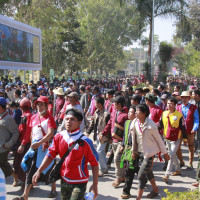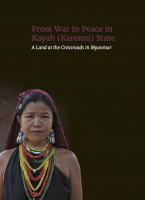The Promise and The Statue A Commentary by Dee De
Regions
The construction of an Aung San statue has caused deep controversy in Kayah State during the past year. Dee De is a member of the Karenni State Farmers Union and Union of Karenni State Youth. He was arrested on 21 June, Karenni National Day, for his involvement in protests. In his commentary, Dee De argues why the construction of the statue is premature and a sensitive issue for the Karenni and other ethnic nationality peoples at this time.

Historical Background
Karenni, known today as Kayah State,* became one of the states in modern-day Myanmar only after the country’s independence in 1948. Before 1948, Karenni existed as an independent land in history. The independence of Karenni was confirmed in a treaty between the British and Burmese King Mindon in 1875 prior to the third Anglo-Burmese War. Located in the borderlands with the Shan States and Siam, the territory had become a source of competition between outside rulers and interests. But due to the deep forests and mountains of the Karenni region, the local people had developed their own political systems, economy and cultures in their own unique way. They had connections with the royal court of the Burmese kings. They were not, however, treated as inferiors but as neighbours and ambassadors for goodwill.
After the annexation of British Burma, the colonial government did not interfere in the traditional systems of administration, economy and culture among the Karenni people. Despite 12 investigations into their status, the Karenni States were never incorporated into British Burma. The main concerns of the British were natural resources, including timber and lead, for which they signed contracts with the Karenni Zaw Pyar (saophas).
Karenni and the Formation of Modern Myanmar
In late 1946, General Aung San travelled with several colleagues to Karenni to try and persuade the people to fight together for independence from British colonization. At that time, General Aung San promised that the struggle for independence was not an attempt at annexation by ethnic Bamar (Burman) leaders in the centre of the country but the goal was an equal union of all peoples. The Japanese invasion, however, during the Second World War had created a great deal of instability and hardship.
In the wake of these sufferings, different opinions arose between those who believed that the interests of the Karenni people would be best helped by collaborating with the new “Pyi Ma” (mother country), while others thought that Karenni should stay independent of the new Union of Burma. Those considering to join the new Union still wanted the historic independence of Karenni to be recognised. Karenni – unlike British Burma – was already an independent state in the view of the people.
In the rush to the British departure, these issues were never properly discussed or resolved. One group of Karenni leaders agreed to work with the new Union. But they did this without discussing the issue with communities in the whole state, and many Karenni people were never consulted. Against this backdrop, a new Karenni State was demarcated in the 1947 constitution but with the right of secession after a 10-year period.
General Aung San was assassinated shortly before Myanmar’s independence in January 1948. Following the British departure, the Karenni and other nationality peoples never enjoyed the equality that Aung San had promised. Instead, they have been continuously ignored by successive governments. The outcome has been conflict, continuing struggles for ethnic rights and the longest-running civil war in the world.
Current Situation
Peoples of all ethnicities, including the Karenni, believed that the original dreams and objectives of equality and self-determination would be implemented after the National League for Democracy won the 2015 general election. In some cases, however, the situation has actually worsened. The NLD has disappointed ethnic nationality peoples around the country on many grounds. The party has not been able to control the armed forces during the present peace process; it has not amended the 2008 constitution or delivered federal reforms that it promised; and there has been more prohibition of freedom of speech under the law. In summary, the NLD appears to give higher priority to imposing authority rather than seeking political solutions that are much needed.
Karenni State and Statue Problem
The problem of building General Aung San’s statue in Karenni has highlighted that the current government has weak management, local understanding and political views for the longterm. Putting a statue in the centre of the state capital Loikaw meant that the government did not care about Karenni history and did not respect the opinion of the Karenni people. The state government did not discuss the issue nor have prior agreement beforehand, and it reacted with violence when protest voices were raised. After initiating the problem, the government avoided meetings with the victims but handed over responsibility for dealing with the crisis to a statue formation committee. Such actions create political conflicts in the community and are an immoral way to deal with a crisis that it created.
Later, the government claimed that they were not invoved in the statue issue. This is not true. Officials have openly taken part, and records show that the government used 40 million kyats from the budget of the road construction department for the statue. This further confirms that the statue was brought in by stealthy means and launched rashly.
The outcome has been highly detrimental. The whole world now knows about the violent response of the authorities who used rubber bullets, tear gas and water cannon to break up a protest by thousands of demonstrators on Union Day, 12th February. Over 20 people were hurt, and 55 youths were sued for their part in the protest, asking for the statue’s removal.
Throughout this time, the government has refused to listen to the people. Karenni youth leaders sent an open letter to the government at the start of the building of the statue. They also spread information about Karenni history and the reason for the statue protest. Subsequently, a Karenni literature committee, political party and ceasefire organistion have also released protest statements. This is a time for reconciliation and national peace-building – not to instigate actions that cause misunderstandings and divide the people. There has also been support for the Karenni people throughout the whole country that the statue should not be built yet. Instead, the union and state governments have used diversoniary methods as a cover to avoid discussion and continue implementing the statue rather than stopping it.
At first, it appeared that some progress had been made. Agreements were reached in a meeting between Karenni youth leaders and the state government following the February protest. It was agreed that the statue plan would be dropped and that the legal cases would be withdrawn against the 55 youths arrested on the day of the demonstration. The state government also said that the issue of removing the statue was not related to them but, instead, local peoples needed to negotiate with the “statue committee members”. However, when approached, the statue committee members said that local groups would have to speak to the government about statue removal because the committee only collected money to transport and launch it.
This is a highly frustrating situation. The statue committee members are not local nationality people. They do not have much accountability, and it is impossible to discuss the case with them because they have already shifted the responsibity back to the government. Therefore there is no choice but to await the response from government regarding the statue removal. A state of impasse has been reached.
Conclusion
The reason for the General Aung San statue protest is based on the need to resolve outstanding issues from Karenni history. In the way that the statue planning and decisions went ahead, there has been no transparency and accountability by the government, no consultation for opinions among local people, and no seeking of participatory agreement. Modern Myanmar came about due to General Aung San’s promises of union and equality. These, however, are yet to be accomplished. In the meantime, Karenni has become one of the poorest and most suffering lands in the country. Therefore, as the peoples of Myanmar seek to build peace and reform together, the statue should not be allowed for the abuse of political power, for the fading of Karenni history, chauvinism, government centralization and disrespect to local people. Such insensitive actions will only hinder the building of peace, democracy and federalism in the longterm.
* In 1951, Karenni State was renamed Kayah State by the central government.
Dee De is a member of the Karenni State Farmers Union and one of the founders of the Union of Karenni State Youth. He is a graduate of Taunggyi University. He took part in the “Vote No” campaign during the 2008 constitutional referendum. He was arrested and sentenced to 32 years’ imprisonment. He was released from prison in 2012 and continued working for the Karenni youth movement. He and his colleagues supported the NLD during the 2015 general election, taking part in Daw Aung San Suu Kyi’s security during her campaign trip to Kayah State. Dee De was arrested in 2017 and spent two months in prison for his involvement in protests against arbitrary killings by the Tatmadaw. He was again arrested this month for campaigning against the Aung San statue. He is currently in Loikaw prison. Dee De married in 2016, and he and his wife have a 4 month-old daughter.

